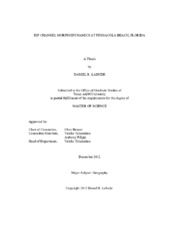| dc.description.abstract | 80% of all lifeguard related rescues along the beaches of northwest Florida are believed to be related to rip currents. A rip current is the strong flow of water, seaward extending from the beach to the breaker line. It has previously been shown that there are rip current hot spots at Pensacola Beach, forced by a ridge and swale topography offshore, but the annual evolution/behavior of these hotspots (i.e. location, size, frequency, and orientation) have not been examined in detail. Remote imagery from Casino Beach was rectified to a planar view in order to examine the rip channel characteristics. These characteristics were analyzed to determine variations and patterns on a daily, monthly, and seasonal basis and in relation to reset storms, wind and wave characteristics, and the beach states of Casino Beach in order to characterize the rip development and variation throughout a year.
Beach states and rip configurations were impacted by many frontal storms and one tropical storm, which were classified as a reset storm when reconfigurations of the beach state and rips occurred. Given sufficient time between reset storms, the bar migrated onshore in a manner consistent with the Wright and Short (1984) model, transitioning from LBT, to RBB, and finally to TBR state. The lack of reset storms after March 2010 resulted in a large frequency of observed rip channels (64) between April and May. It is shown that these rip channels are clustered into 7 statistically significant groups based on their location alongshore at the 95 % confidence interval. It is argued that the rip channel clusters are a direct result of the wave forcing caused by the ridge and swale topography. This situation causes the bar to move onshore that without interruption of a reset storm will attach at certain locations creating a transverse bar and rip morphology. The bar appears to attach to the beach at consistent locations throughout the year creating similar rip locations and subsequently the rip clusters. The risk posed to beach users by these rip currents is concentrated in certain locations which are persistent throughout the year. | en |


